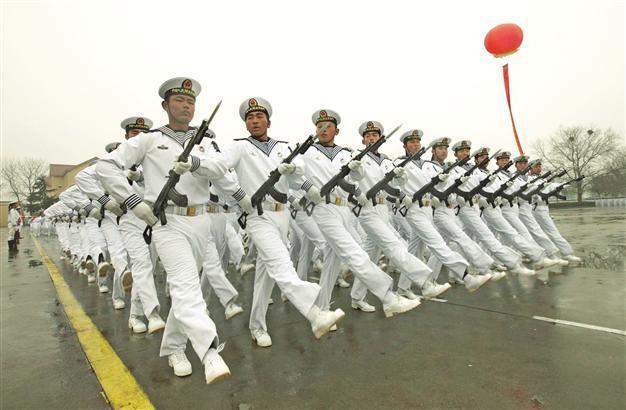Russia, China boost army spending
STOCKHOLM

Chinese sailors march during a parade at a training base of China’s North Sea Fleet in Qingdao in the eastern Shandong province in this file photo. The country spent 6.7 percent more on arms in 2011 than 2010, with around $143 billion in total expenditure. AP photo
The global financial crisis hit
military spending in the United States and Europe last year, while
Russia and
China continued to increase weapons spending, a Swedish think tank said yesterday.
The Stockholm International Peace Research Institute (SIPRI) said budget cuts kept worldwide military expenditures nearly flat at 0.3 percent in 2011, with a total of $1.74 trillion spent, marking an end to an 11-year growth trend in
arms expenditure. The U.S. was the world’s leading arms buyer, although it cut its military expenditure by 1.2 percent to $711 billion, while Europe marginally increased its spending to $407 billion.
Russia overtook Britain and France to become the world’s third largest arms spender, with $71.9 billion, a 9.3 percent increase over 2010. China also spent 6.7 percent more on arms in 2011 than 2010, with around $143 billion in total expenditure, remaining the world’s second largest arms investor. “The aftereffects of the global economic crisis, especially deficit-reduction measures in the U.S. and Europe, have finally brought the decade-long rise in military spending to a halt, at least for now,” The Associated Press quoted Sam Perlo-Freeman, head of SIPRI’s Military Expenditure Project, as saying.
Biggest increase from AzerbaijanLast year, six of the world’s top military spenders, Brazil, France, Germany, India, Britain and the U.S., cut their military budgets. One of the key reasons for the U.S.’s slight decline in spending was a long delay in Congress reaching an agreement on a 2011 budget, as the Obama administration clashed with Republicans over measures to reduce the deficit, SIPRI said.
The institute expects American arms spending to continue to fall, due to the withdrawal of U.S. forces from Iraq, the drawdown of U.S. forces in Afghanistan, and the Budget Control Act, passed by Congress last year. Another figure shows that Azerbaijan had the largest percentage increase in arms spending worldwide in 2011, with 89 percent more military spending, amidst increasing warnings of renewed conflict with Armenia over the disputed Nagorno-Karabakh region.
Turkey’s spending decreasesThe country has also seen the largest increase in arms spending in Europe for the 2008-2011 period, with expenditures increasing nearly 60 percent. Greek Cyprus had the second largest increase in the same period, with nearly 20 percent more spending.In 2011, Turkey decreased its military expenditures, for a total of $17.9 billion spent. Turkey’s military expenditure decreased 12 percent compared to its 10-year average, the BBC’s Turkish website quoted the report as saying. Russia’s growing expenditure was mainly driven by the country’s goal of replacing 70 percent of its Soviet-era military equipment with modern weaponry by 2020, SIPRI said, adding that it expects the Kremlin to increase its military spending in coming years. Perlo-Freeman said Russia lacks important modern communications technology for the battlefield and wants to hedge against America’s overwhelming military might. SIPRI said China’s spending is in line with its overall economic growth, and has remained stable at around 2 percent of the country’s GDP since 2001. It noted that China’s increased arms spending has caused concern among its neighbors and contributed to higher arms outlays in both India and Vietnam.
defense, Medvedev, Putin,
